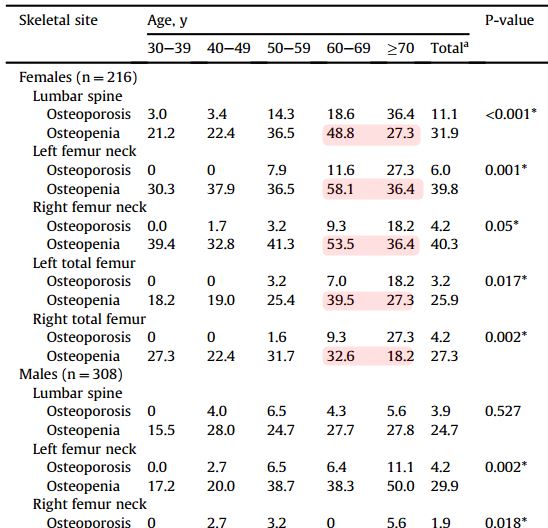Osteopenia in 40 percent of Indian women
Prevalence of osteoporosis and osteopenia in an apparently healthy Indian population - a cross-sectional retrospective study
Osteoporosis and Sarcopenia, https://doi.org/10.1016/j.afos.2018.04.002, online 5 May 2018
Neelam Kaushala, , Divya Vohoraa, , , Rajinder K. Jalalib, Sujeet Jhac, ,
📄 Download the PDF from Vitamin D Life

Note the huge decrease in osteopenia/osteoporosis for those aged 70+
Suspect the decrease is due to
Death due to hip fracture
Less able to get to hospital for health checkup

Objectives
An understanding of bone mineral density (BMD) pattern in a population is crucial for prevention and diagnosis of osteoporosis and management of its complications in later life. This study aimed to screen the bone health status and factors associated with osteoporosis in an apparently healthy Indian population.
Methods
A retrospective review of medical records was done in a tertiary-care hospital for the subjects who had undergone preventive health-check-ups that included BMD measurements at femur-neck, total-femur, and lumbar-spine.
Results
We evaluated 524 subjects (age, 50.0 ± 12.4 years) including 41.2% female and 58.8% male subjects. Osteoporosis was present in 6.9% subjects (female, 11.1%; male, 4.2%) and osteopenia in 34% subjects (female, 40.3%; male, 29.9%). Absolute BMD was higher in male subjects (P < 0.001) compared to female subjects at all bone sites. Prevalence of osteoporosis increased with age in female subjects, but not in male subjects.
Osteoporosis rates in the age-groups of 30–39, 40–49, 50–59, 60–69, and ≥70 years were 3%, 3.4%, 14.3%, 18.6%, and 36.4%, respectively in female subjects while prevalence in male subjects was 0%, 4%, 6.5%, 4.3%, and 5.6%, respectively, at lumbar spine. Height (r = 0.234–0.358), weight (r = 0.305–0.388), body mass index (r = 0.143–0.285) and physical activity (r = 0.136–0.153) were positively; and alkaline phosphatase (r = −0.133 to −0.203) was negatively correlated with BMD (all P < 0.01) at all sites. These parameters retained significant correlation after controlling for age and sex. No correlation of serum 25-hydroxy-vitamin-D and calcium was noted with BMD (P > 0.05) at any site.
Conclusions
Further data on absolute BMD, T scores, and prevalence rates of osteoporosis/osteopenia on multiple bone sites have been presented in this article.
